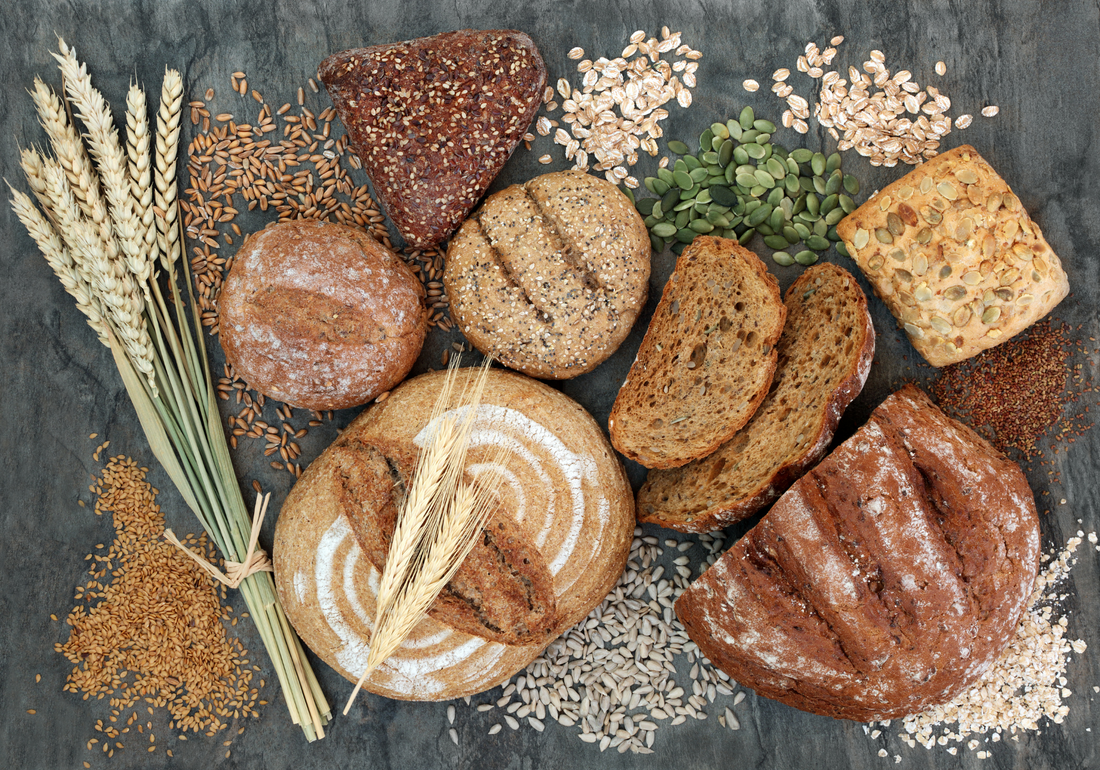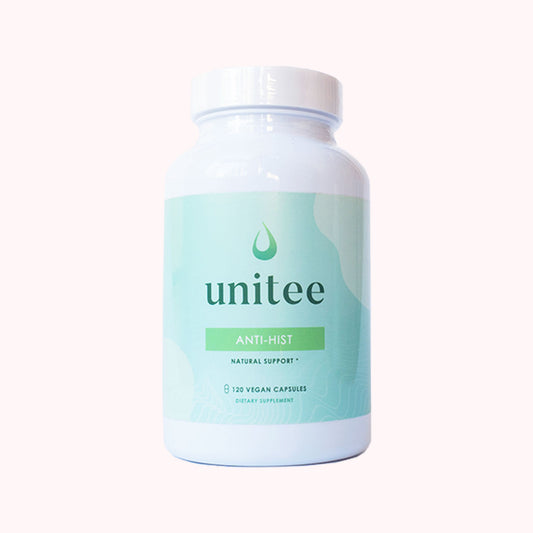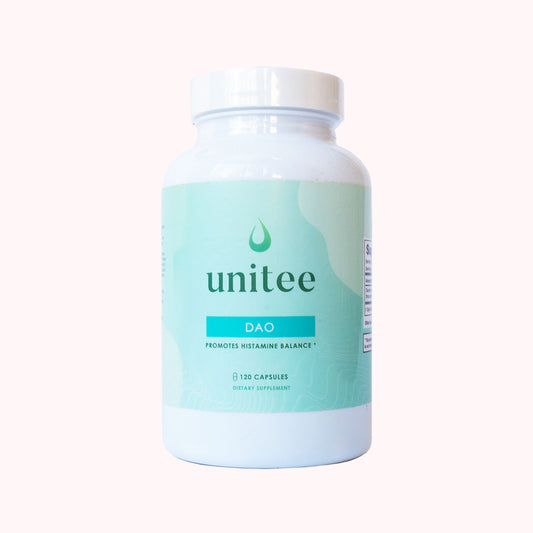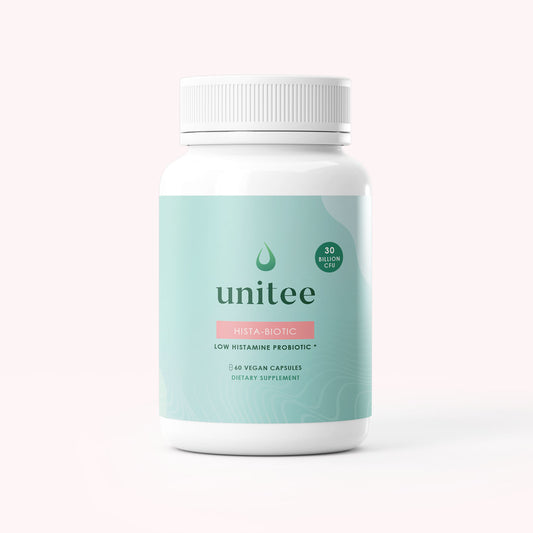Many people have a lowkey best friend: fiber.
And if you have histamine intolerance, it really should be!
You may laugh at this idea, but realistically, fiber is actually the bestest of best friend that your gut can have. Or should I say, your gut bacteria, can have... Considering we have over 100 trillion bacteria inhabiting our intestines, fiber is truly a better friend than you may think.
When you think about the relationship that your gut health has with your symptoms of histamine intolerance, you'll understand just how important getting the right amount of fiber is for managing your condition.
So today I’d like to give you all a little lesson on fiber: what it is, why it’s so good, and exactly how much fiber per day is the right amount you need to get to maximize your gut health when you're living with histamine intolerance.
I should really note here before we get into it, that getting more fiber isn't for everybody. There are many individuals that cannot tolerate fiber very well, particularly those whose histamine intolerance is associated with small intestinal bacterial overgrowth (SIBO), which is a common cause of IBS-related histamine issues.
So, if you've been shoving fiber down your gullet and feeling like garbage, maybe you should hold off and check for SIBO or other common digestive issues before continuing to do this and hoping it gets better.
However, for the majority of individuals with histamine intolerance, who can tolerate fiber, adding it into your diet and implementing slow increases to reach higher levels is great.
For those people: this article is for you!
What Is Fiber? And How Does It Impact the Symptoms of Histamine Intolerance?
Fiber is a dietary material that comes in all shapes and sizes. It has two common forms, soluble and insoluble. The soluble kind will dissolve in water, while the insoluble kind doesn't. And the benefits of fiber come from the fact that, believe it or not, it is actually resistant to the action of the digestive process, making it indigestible by the human body.
Although we may not be able to digest fiber, it’s actually used in several processes within our body, including reactions with gut bacteria to produce a whole bunch of health-enhancing results.
The list of benefits of dietary fiber is long, and it would be a hefty post to cover them all – so, I’m going to discuss a few benefits of dietary fiber that are common and may be relevant to you (1).
Three Top Benefits of Fiber for Histamine Intolerance
Fiber Helps You Poop
Insoluble fiber, the one that doesn't dissolve in water, is the type of fiber you need in your diet to help you go to the bathroom and makes moving your bowels easier. It moves through the digestive system relatively unchanged, adding bulk to your stools, which helps to trigger the muscles in the digestive system to initiate a bowel movement.
This is an essential part of life and helps you to detoxify your body by getting rid of unwanted and sometimes harmful substances through defecation. It's an especially important process when it comes to histamine intolerance. Not only does it help to rid the body of toxins that may cause unwanted symptoms such as bloating and abdominal pain, but it can help to reduce the times that mast cells flare up and helps to maintain the health of the intestines as well as keep immune and inflammatory processes in balance.
Just be sure that if you’re eating a lot of fiber, you also drink enough water throughout the day. If there is insufficient water to parallel your fiber intake, you may experience the opposite effect and actually feel more constipated from increasing the amount of fiber you eat every day. Even though insoluble fiber doesn't need water to be processed, it can still cause drying of the stools and irritation within the digestive tract if there is not enough water to facilitate bowel movements.
Fiber Regulates Appetite
Fiber also helps to keep you full; something that those of you living with histamine intolerance may not experience very often because of your limited diet.
When you eat fiber rich foods, it slows the passage of nutrients through the digestive tract, which sends signals to the brain that tells the gut to release certains chemicals. These chemicals support the feeling of satiety, which means you're less likely to want to reach for a sugary snack that may complicate your symptoms of histamine intolerance and perpetuate the underlying causes of the condition, such as a candida overgrowth.
Fiber Supports a Healthy Gut Bacterial Balance
Fiber supports the growth of a healthy gut bacterial balance within the body. This is so important, as fiber is now demonstrating that gut bacteria are involved in basically every single process within the body. Think everything from hormonal balance to detoxification to immune health and anything in between.
To demonstrate the importance of using fiber to support healthy gut bacteria levels, several studies have used two identical mice, intentionally altering the bacterial balance in one of the mice to resemble unbalanced bacterial colonies within the digestive system. In these studies, both mice were given the exact same diet and exercise routine. Interestingly, the mouse who maintained their healthy bacterial balance stayed perfectly lean, while the mouse who had the altered, unbalanced gut bacteria became severely obese (2)!
As we now know, obesity is associated with a host of other health conditions, so this change can contribute to body-wide health issues.
By supporting a healthy gut bacteria, you can see improvements in keeping your overall body healthy, your skin condition, your body composition, and even digestive symptoms and illnesses that you may currently have or want to prevent against (3).
This point is also relevant to those experiencing histamine intolerance symptoms. As we know, one of the root causes of histamine intolerance can be due to bacterial imbalances. In particular, when there's a shift to an overgrowth of histamine-producing bacteria, which cause levels of histamine in the body to rise significantly.
An overgrowth of histamine-producing bacteria can be paired with other issues that cause histamine levels to remain uncontrolled, having a chronic influence throughout the body. For example, an inability to make enough diamine oxidase (DAO) enzymes to break down the histamine being produced can result in histamine-related allergy-like symptoms. Unfortunately, it's not something that will likely show up on an allergy test because the body is not necessarily reacting to any specific toxin or allergen; there's simply too much histamine being made and not enough resources to cope!
As you've seen, fiber has a very important role here, helping to maintain the levels of helpful bacteria that keep those histamine-producing bacteria under control (4). So, even if you do have a DAO deficiency, you're not over producing histamine and using up your supply of the enzyme.
So, how do you get enough fiber?
Get Your Free Histamine Guide!
How Much Fiber Per Day is Optimal to Manage Your Symptoms of Histamine Intolerance?
It’s a widely known fact that people in Western countries do not consume enough daily fiber. Historically, our ancestors would often consume over 100g throughout the day; think hunter-gatherers and how much fruit and vegetables they would consume!
That's no longer the case. Currently, in North America, individuals consume an average of less than 17g per day.
That's less than 2%!
Although our digestive systems would likely have a pretty rough time trying to deal with hundreds of grams of fiber daily, too little poses just as great a problem. There’s no doubt about the fact that we definitely need to up our intake in order to both fix and prevent many symptoms and disorders.
So, how much fiber per day is the right amount to achieve amazing benefits for your body and your gut health?
Several studies have demonstrated that the most significant benefits of fiber appear when consuming 30g or more of fiber daily. This amount of fiber has been shown to enhance a range of bodily systems including regulating hunger and fullness hormones, balancing gut bacteria, and supporting immune health (5).
If you experience histamine intolerance symptoms, that last point is also of particular importance as histamine is an integral part of the immune system.
Research shows that the metabolites, called short chain fatty acids, which are produced by feeding the healthy gut bacteria fiber, can help to stabilize the immune cells responsible for mast cell degranulation and histamine release.
How Much Fiber Is Too Much When You’re Living With Histamine Intolerance?
If you’re reading this post, your goal is likely to find out how much fiber per day is optimal to reach your digestive health goals.
If 35g per day or higher has shown to have extensive benefits, the next question you may be wondering is whether you can consume too much fiber.
The answer to that is a somewhat reluctant no. As I mentioned, our ancestors used to often consume over 100g daily. Realistically, if you want to slowly build your way up to 100g of fiber per day and your body can probably learn to handle it. And it could mean the critters living in your digestive system are going to be one happy bunch.
However, the reason this answer isn’t so firm is because, of course, for centuries, the human body hasn't been used to consuming so much fiber. If you're living with histamine intolerance, this is likely most true for you as you've probably been diagnosed with IBS and followed a low FODMAP diet for some time.
So, if you tried to switch to such a high fiber diet quickly, you would probably experience as exacerbation of you unwanted and highly unpleasant symptoms (6). These symptoms can include bloating, a drastic change in stool consistency, excess gas as well as pain or discomfort in the abdomen. It's typically a reason most people then avoid eating a higher fiber diet. But with the repercussion that then perpetuates the problem and most likely, can leave you with those symptoms anyways.
While it might sound like there's no winning with fiber, there is! Whether you’re aiming for 35g or 100g of fiber daily, there’s a particular way to increase your fiber intake that will help you to avoid those unwanted symptoms and only reap all of the benefits.
Which brings me to the next point...
Get Your Free Histamine Guide!
Increasing Your Fiber Without Exacerbating Your Histamine Intolerance Symptoms
The correct way to increase your fiber without significant unwanted symptoms, whether you're living with histamine intolerance or just want to improve your digestive health, is through a dose-escalation method. This method works by increasing your fiber slowly by just a few grams per day or per week, depending on what your body ends up feeling comfortable with. Some might tolerate a larger intake right off the bat, and others need to go as slowly as adding just a gram or two! Always start slow and low, and work your way up from there.
If you begin to experience any unwanted symptoms, stop increasing or, if there’s too much discomfort, back off the fiber a little then retry the same increase after one week.
This method will allow your body time to adjust to the increase in fiber, allowing your gut bacteria to slowly get used to using it again. Remember: it is highly important to increase your water intake as you increase your fiber intake so that you're also facilitating the movement of the roughage through your digestive tract!
The key is to take it slow – if you try to push your body to health too quickly, you’re not doing yourself any favours and it might just backfire.
So there you have it, the full breakdown of how much fiber to eat daily and what to expect! I hope this helps to bring a little more radiance and comfort to your quality of life.
References:
- Barber TM, Kabisch S, Pfeiffer AFH, Weickert MO. The Health Benefits of Dietary Fibre. Nutrients. 2020;12(10):3209. Published 2020 Oct 21. doi:10.3390/nu12103209
- Dayib M, Larson J, Slavin J. Dietary fibers reduce obesity-related disorders: mechanisms of action. Curr Opin Clin Nutr Metab Care. 2020;23(6):445-450. doi:10.1097/MCO.0000000000000696
- Fu J, Zheng Y, Gao Y, Xu W. Dietary Fiber Intake and Gut Microbiota in Human Health. Microorganisms. 2022;10(12):2507. Published 2022 Dec 18. doi:10.3390/microorganisms10122507
- Schnedl WJ, Enko D. Histamine Intolerance Originates in the Gut. Nutrients. 2021;13(4):1262. Published 2021 Apr 12. doi:10.3390/nu13041262
-
McKeown NM, Fahey GC Jr, Slavin J, van der Kamp JW. Fibre intake for optimal health: how can healthcare professionals support people to reach dietary recommendations?. BMJ. 2022;378:e054370. Published 2022 Jul 20. doi:10.1136/bmj-2020-054370
- Ioniță-Mîndrican CB, Ziani K, Mititelu M, et al. Therapeutic Benefits and Dietary Restrictions of Fiber Intake: A State of the Art Review. Nutrients. 2022;14(13):2641. Published 2022 Jun 26. doi:10.3390/nu14132641

Anita Tee
My name is Anita Tee. I'm a nutritional scientist who specializes in histamine intolerance. I hold a Master of Science in Personalized Nutrition and a Bachelor of Science in Human Biology and Psychology. For the past ten years, I have used my experience in nutritional and medical health sciences to create a scientifically backed, natural approach to healthcare that relies 100% on evidence-based research. As I previously suffered from - and overcame - histamine intolerance, my focus is to increase recognition and expand the available resources and protocols available for resolving this particular disorder. To date, I have helped over 4,000 individuals fully resolve or better manage their histamine intolerance symptoms.







